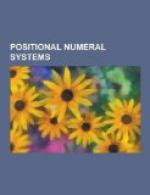|
This section contains 965 words (approx. 4 pages at 300 words per page) |

|
The Binary Number System
Binary arithmetic is the type of arithmetic that virtually all digital computers use while performing numerical operations (addition, subtraction, multiplication, division, and comparison). The binary number system uses two digits: 0 and 1. All modern digital computers represent data as a collection of such binary digits or bits. A bit is the smallest possible unit of information, and can exist in one of two states: 0 (also labeled "off" or "false") and 1 (also labeled "on" or "true"); a valid bit cannot be halfway between 0 and 1, or both at once. All collections of computer data, such as text files on disks, programs stored in memory, and web pages on the Internet, are ultimately collections of bits.
Since each bit has two possible states (0 and 1), two bits together have four possible states (00, 01, 10, 11), three bits have eight states (000, 001, 010, 011, 100, 101, 110, 111), and so on. The number of possible states of a...
|
This section contains 965 words (approx. 4 pages at 300 words per page) |

|


